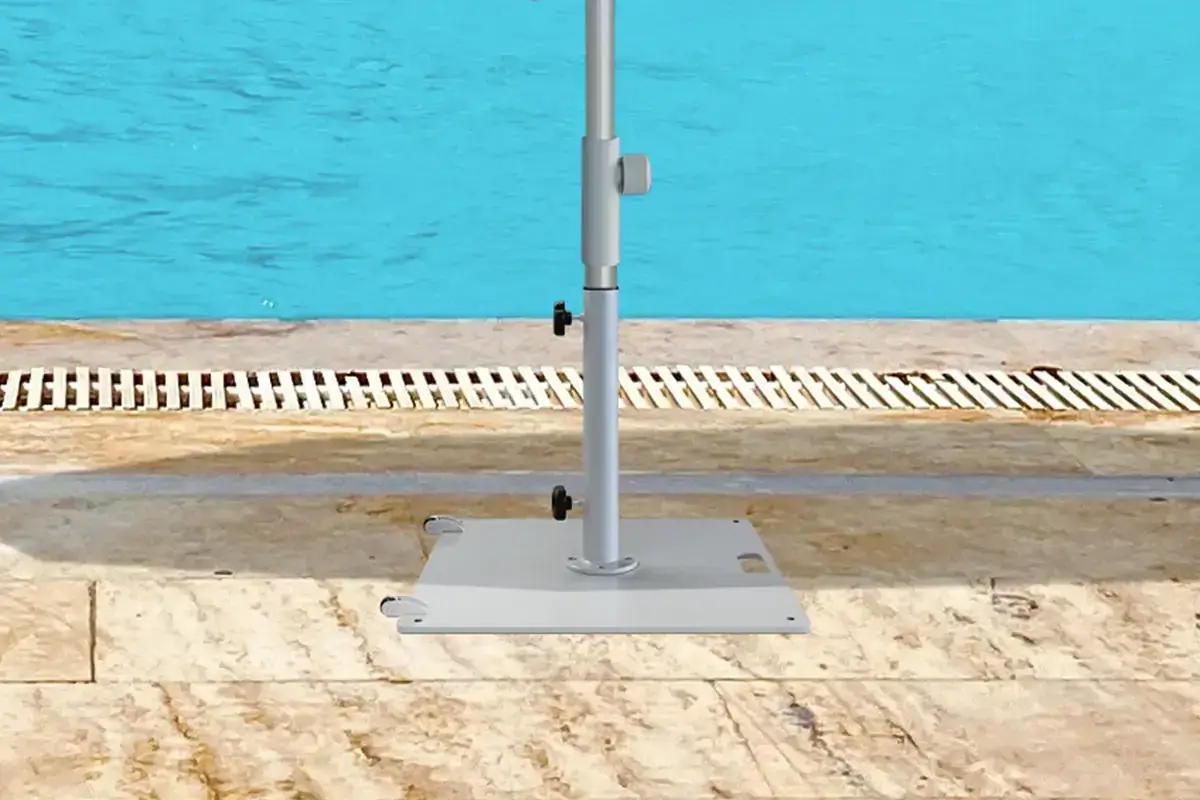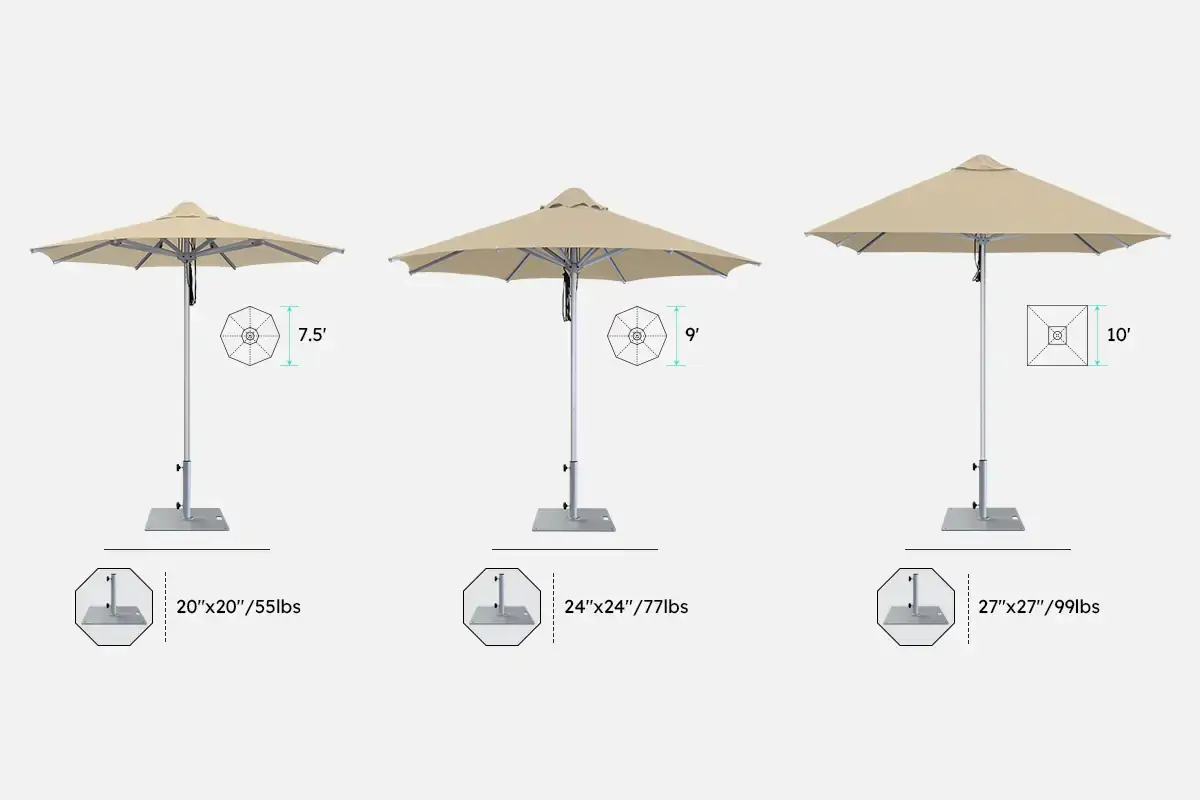
A patio umbrella is a perfect shade solution for your outdoor space. But if the base is not heavy enough, your umbrella can easily tip over or be damaged by the wind. Whether you’re dealing with strong winds or simply want to ensure a solid foundation, selecting the right base weight will enhance its safety and stability.
You might be wondering: how heavy should an umbrella base be? This guide will introduce you to the ideal base weight for patio umbrellas. It also covers the factors you need to consider when determining the weight. Check out our guide to find the best umbrella base for your needs.
The Difference Between Umbrella Base and Umbrella Stand
Both umbrella bases and umbrella stands are supports for fixing patio umbrellas, but they differ in some aspects. An umbrella base can be placed under the table. It is commonly used for straight umbrellas and tilt umbrellas. However, an umbrella stand is free-standing and usually used for cantilever and offset umbrellas. These two types can be used in various outdoor locations.
How Heavy Should an Umbrella Base Be?

A patio umbrella must be properly secured to prevent it from falling or tipping over. Using an umbrella base is the most convenient and effective way to stabilize the umbrella. However, a heavy umbrella base may make it difficult to move, while a light one won’t provide enough stability. So, how heavy of an umbrella base do I need?
The optimal base or stand weight depends on the patio umbrella size. Generally, the larger the umbrella, the heavier the base should be. If your umbrella is used with a table, the base weight could be reduced by about 20 pounds, as the table provides additional support to the umbrella. Here is a suggested minimum base weight:
| Umbrella Size | Minimum Base Weight |
| 6-9 ft | 35-50 lbs |
| 10-11 ft | 50-75 lbs |
| ≥12 ft | At least 95 lbs |
Notes:
- If it is a free standing umbrella, add at least 20 pounds to the base weight.
- If you are in windy areas, add at least 15 pounds to the base weight.
- For the best stability, consider using 10 pounds of weight per foot of canopy diameter. For example, the optimal umbrella base weight for 9 ft umbrella is 90 pounds.
Factors to Consider for Umbrella Base Weight
Whether you are using the patio umbrella through a table or have it freestanding, consider the factors that can affect the base weight.
Umbrella Sizes

There is no doubt that the umbrella base weight mainly depends on the umbrella size (canopy diameter). Small umbrellas can be supported by a lighter base, while large umbrellas require a heavier one for stability. Therefore, you can start by choosing suitable patio umbrella sizes for your needs, and then consider the optimal base for umbrella.
Type of Ground Surfaces
Different ground surfaces affect the patio umbrella base weights. Compared to the hard surface, the soft surface requires more weight to maintain stability. Because the base may sink into the soft ground, affecting the stability of the patio umbrella. In addition, you can use in ground umbrella base for better stability on soft surfaces. Many merchants provide different types of umbrella base, like Westshade. They offer various umbrella bases, including in-ground bases, to meet your needs.
Windy Conditions
Wind conditions can significantly affect the base weight needed for a patio umbrella. If the weighted umbrella base is not heavy enough, even a securely set-up umbrella can become dangerous in heavy winds. In coastal areas or open locations where the wind is strong, you’d better use a heavier base for safety. In general, the base weight should be at least 10 pounds of weight per foot of canopy diameter. If you plan to use the umbrella in a backyard or sheltered location where the wind is milder, a lighter base may be sufficient.
Ensuring Long-Term Stability
Choosing the right umbrella base weight is just the first step; proper care and usage are essential to keeping your umbrella stable and safe for the long haul.
Tighten the Securing Knob
Most bases have a knob to tighten the umbrella pole in place. Make sure it’s fastened firmly, or the pole may wobble.
Close Your Umbrella in High Winds

No matter how heavy your base is, strong winds can tip over or damage your umbrella. Always close it when not in use or during inclement weather.
Inspect for Wear and Tear
Regularly check both the umbrella and the base for cracks, rust, or other signs of damage. Addressing small issues early helps prevent accidents and extends the life of your setup.
Check Fill Levels in Weighted Bases
If you’re using a fillable base (like one filled with water or sand), inspect it periodically to ensure it’s still at the right fill level. Water can evaporate, and sand can settle or clump, reducing the base’s stability over time.
FAQs
Is it better to fill an umbrella base with sand or water?
It depends on the environment where it is used. Sand for umbrella base provides more stability and durability, while water is lightweight and portable. If you are in a windy area, you’d better fill the base with sand for stability. And if you want to move your umbrella frequently, consider filling it with water for easier transport.
What is the best material for an umbrella base?
Patio umbrella bases come in various materials, each with its advantages. The most common materials are coated metal, heavy-duty plastic, and granite. Metal bases are sturdy, but their coating is prone to scratching. Plastic bases are the most affordable option. They can be filled with water or sand when in use, but they are less durable and may crack over time. Granite bases are durable and long-lasting, but they are difficult to move. You can opt for the most suitable material according to your needs.
What should I look for in an umbrella base?
Size and weight must be considered first. Generally speaking, the base weight should be at least 10 pounds per foot of canopy diameter. For larger umbrellas or in windy, open areas, the heavier the base, the better the stability.
After weight, consider the base type (fillable or solid), whether it includes wheels for easy mobility, its aesthetic appeal, and any additional features that suit your outdoor setup. Always choose based on your specific environment and needs.
How to move a heavy umbrella base?
Firstly, close the umbrella for safety. Then you can move the umbrella base. The most convenient way is to pick an umbrella base with wheels, which allows you to easily move the heavy base. If the base does not feature wheels, you can use a trolley or other transport tool to move it.
If you don’t have the tools available, you can ask your friends or family members for help. Working with multiple people can distribute the weight and reduce the risk of injury. Whether you use tools or work with partners, be sure to maintain balance during the operating process.
Conclusion
The optimal weight of patio umbrella base depends on factors like umbrella size, ground surfaces, and wind conditions. Normally, larger umbrellas require heavier bases. And if the outdoor umbrella is freestanding or used in a windy location, additional weight is a must to secure it from tipping over. Choosing the right base weight for your patio umbrella is essential to ensure safety, stability, and longevity.
If you want to buy a patio umbrella or umbrella base, check out Westshade! We provide a wide range of patio umbrellas and umbrella bases to fit your needs.
Enjoy our special Christmas promotion with 20% off sitewide on all regular-priced items from December 11th to January 5th. Use code CM2025 at checkout and make the most of this festive season to upgrade your outdoor space. Don’t hesitate to explore the quality offerings at Westshade!








